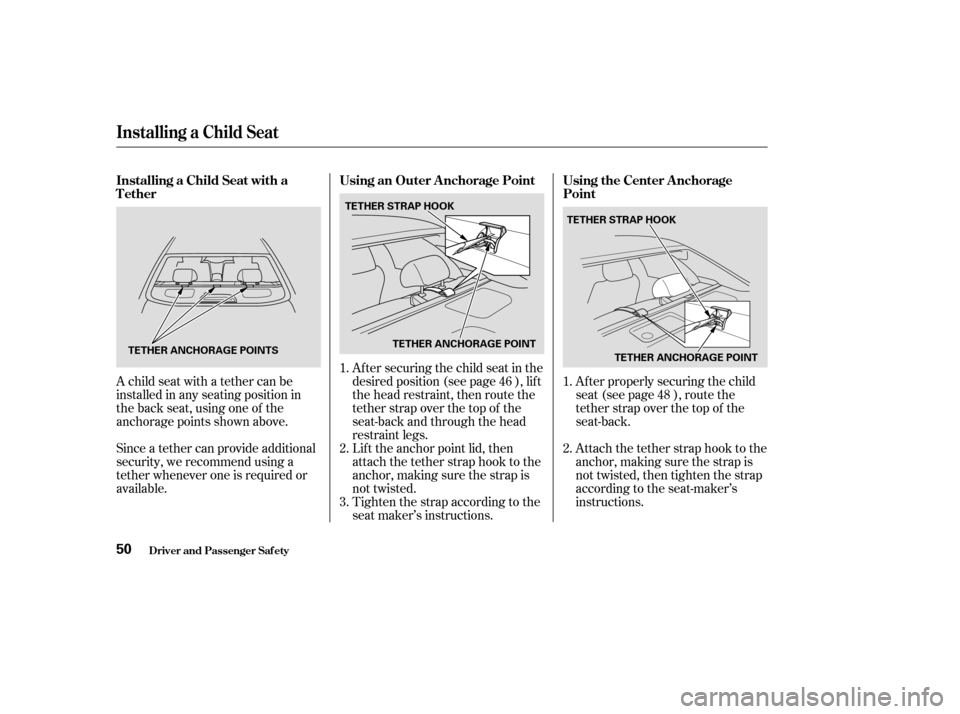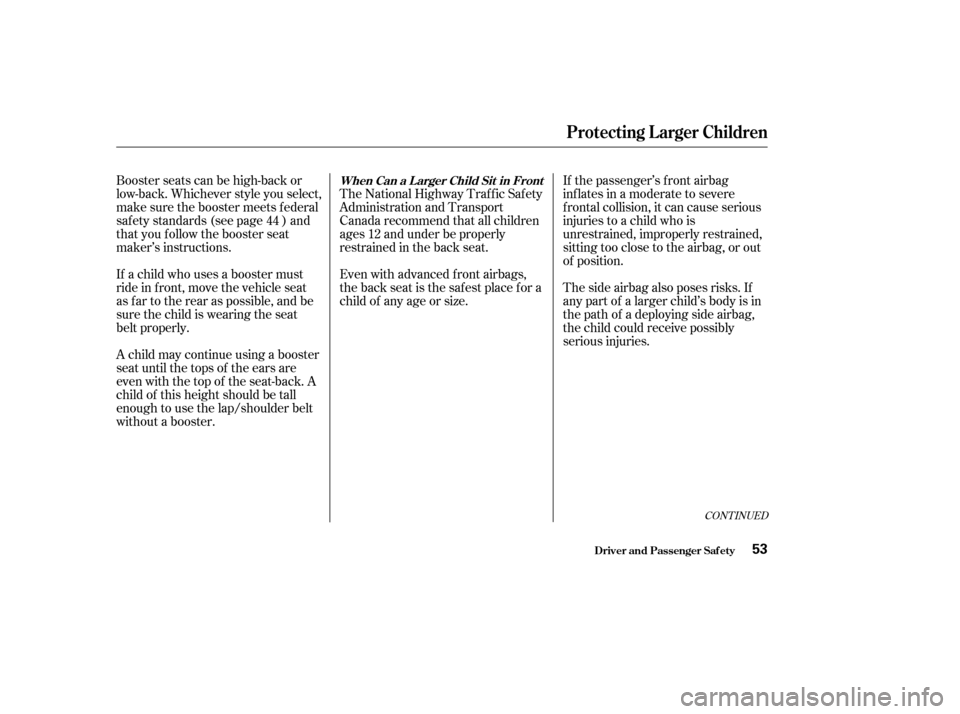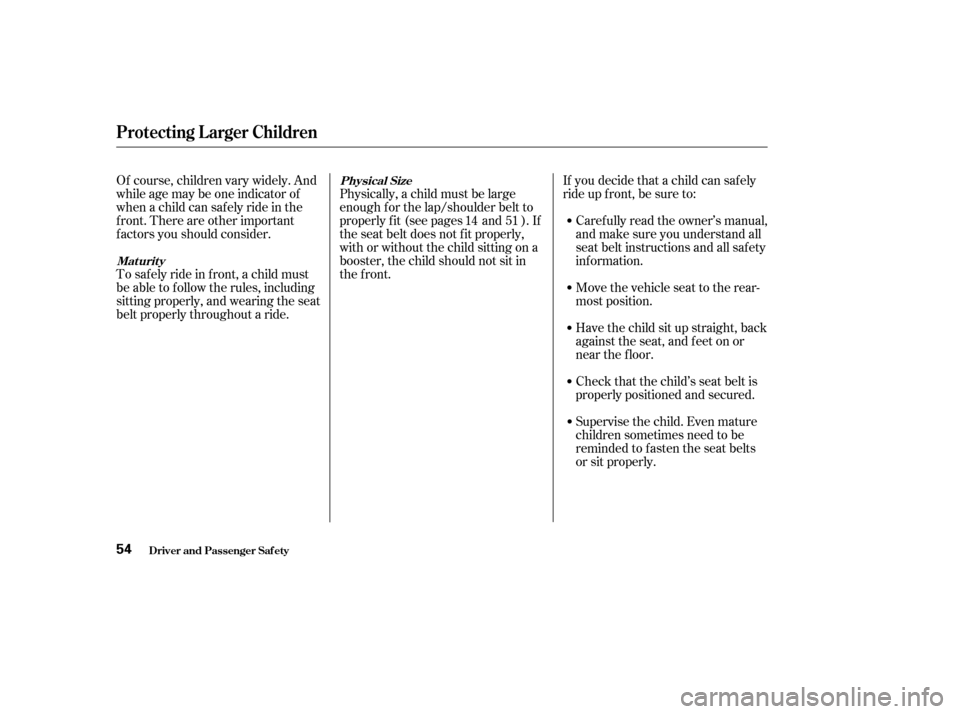Page 45 of 301
Your vehicle is equipped with
LATCH (Lower Anchors and
Tethers for Children) at the outer
rear seats. The lower anchors are
located between the seat-back and
seat bottom, and are to be used only
with a child seat designed f or use
with LATCH.Place the child seat on the vehicle
seat, and attach the seat to the
lower anchors according to the
child seat maker’s instructions.
Some LATCH-compatible seats
have a rigid-type connection as
shown above.
To install a LATCH-compatible child
seat:
Move the seat belt buckle or
tongue away f rom the lower
anchors.
Make sure there are no objects
near the anchors that could
prevent a secure connection
between the child seat and
anchors.
Small marks are positioned to
indicate the locations of each anchor
point. 1. 2.
3.
Installing a Child Seat Using
LATCH
Installing a Child Seat
Driver and Passenger Saf ety46
Rigid type
LOWERANCHORMARKS
�����—�����—�����y�
�
����
������y���
�(�������
���y���������y
Page 47 of 301
When not using the LATCH system,
all child seats must be secured to the
vehicle with the lap part of a lap/
shoulder belt.With the child seat in the desired
seating position, route the belt
through the child seat according
to the seat maker’s instructions,
then insert the latch plate into the
buckle.To activate the lockable retractor,
slowly pull the shoulder part of the
belt all the way out until it stops,
then let the belt f eed back into the
retractor.
Af ter the belt has retracted, tug on
it. If the belt is locked, you will not
be able to pull it out. If you can pull
thebeltout,itisnotlocked,and
you will need to repeat these steps.
In addition, the lap/shoulder belts in
the back seat and the front
passenger seat have a locking
mechanism that must be activated to
secure a child seat.
1.2. 3.
Inst alling a Child Seat wit h a L ap/
Shoulder Belt
Driver and Passenger Saf ety
Installing a Child Seat
48
�����—�����—�����y�
�
�����������y���
�(�������
���y�������
�y
Page 49 of 301

A child seat with a tether can be
installed in any seating position in
the back seat, using one of the
anchorage points shown above.
Since a tether can provide additional
security, we recommend using a
tether whenever one is required or
available.Af ter securing the child seat in the
desired position (see page ), lif t
the head restraint, then route the
tether strap over the top of the
seat-back and through the head
restraint legs.
Lif t the anchor point lid, then
attach the tether strap hook to the
anchor, making sure the strap is
not twisted.
Tighten the strap according to the
seat maker’s instructions.Af ter properly securing the child
seat (see page ), route the
tether strap over the top of the
seat-back.
Attach the tether strap hook to the
anchor, making sure the strap is
not twisted, then tighten the strap
according to the seat-maker’s
instructions.
1. 2. 3.
1. 2.
46
48
Installing a Child Seat
Driver and Passenger Saf ety
Installing a Child Seat with a
Tether Using an Outer A nchorage Point Using the Center A nchorage
Point
50
TETHER STRAP HOOK
TETHER ANCHORAGE P OINTS TETHER ANCHORAGE P
OINTTETHER STRAP HOOK
TETHER ANCHORAGE P OINT
�����—�����—�����y�
�
�����������y���
�(�������
���y���������y
Page 52 of 301

Booster seats can be high-back or
low-back. Whichever style you select,
make sure the booster meets f ederal
saf ety standards (see page ) and
that you f ollow the booster seat
maker’s instructions.
If a child who uses a booster must
ride in f ront, move the vehicle seat
as far to the rear as possible, and be
sure the child is wearing the seat
belt properly.
A child may continue using a booster
seat until the tops of the ears are
even with the top of the seat-back. A
child of this height should be tall
enough to use the lap/shoulder belt
without a booster.The National Highway Traffic Safety
Administration and Transport
Canada recommend that all children
ages 12 and under be properly
restrained in the back seat.
Even with advanced front airbags,
the back seat is the saf est place f or a
child of any age or size.
If the passenger’s f ront airbag
inf lates in a moderate to severe
f rontal collision, it can cause serious
injuries to a child who is
unrestrained, improperly restrained,
sitting too close to the airbag, or out
of position.
The side airbag also poses risks. If
any part of a larger child’s body is in
the path of a deploying side airbag,
the child could receive possibly
serious injuries.
44
CONT INUED
Protecting L arger Children
Driver and Passenger Saf ety
When Can a Larger Child Sit in Front
53
�����—�����—�����y�
�
�����������y���
�(�������
���y���������y
Page 53 of 301

Of course, children vary widely. And
while age may be one indicator of
when a child can saf ely ride in the
f ront. There are other important
f actors you should consider.
To saf ely ride in f ront, a child must
be able to f ollow the rules, including
sitting properly, and wearing the seat
belt properly throughout a ride.If you decide that a child can saf ely
ride up f ront, be sure to:
Caref ully read the owner’s manual,
and make sure you understand all
seat belt instructions and all saf ety
inf ormation.
Have the child sit up straight, back
against the seat, and feet on or
near the f loor.
Check that the child’s seat belt is
properly positioned and secured.
Physically, a child must be large
enough f or the lap/shoulder belt to
properly f it (see pages and ). If
the seat belt does not f it properly,
with or without the child sitting on a
booster, the child should not sit in
the front.
Move the vehicle seat to the rear-
most position.
Supervise the child. Even mature
children sometimes need to be
reminded to f asten the seat belts
or sit properly.
14 51
Maturity
Physical Size
Protecting L arger Children
Driver and Passenger Saf ety54
�����—�����—�����y�
�������������y���
�(�������
���y���������y
Page 54 of 301
This could result in
serious neck injuries during a crash.
This could cause
very serious injuries during a crash.
It also increases the chance that the
child will slide under the belt in a
crash and be injured.
If they do, they could
be very seriously injured in a crash.
Devices intended to improve a
child’s comf ort or reposition the
shoulder part of a seat belt can make
the belt less ef f ective, and increase
the chance of serious injury in a
crash.
Additional Saf ety Precautions
Do not let a child wear a seat belt
across t he neck.
Do not let a child put the shoulderpart of a seat belt behind t he back orunder t he arm.
T wo children should never use t hesame seat belt .
Do not put any accessories on a seatbelt.
Protecting L arger Children
Driver and Passenger Saf ety55
�����—�����—�����y�
�
�������
���y���
�(�������
���y���������y
Page 62 of 301

On all V6 models
Only on models equipped with side airbags
This indicator lights brief ly when
you turn the ignition switch to ON
(II). If it comes on at any other time,
it indicates a potential problem with
your f ront airbags. This indicator will
also alert you to a potential problem
with your side airbags, passenger’s
side airbag automatic cutoff system,
side curtain airbags, automatic seat
belt tensioners, driver’s seat position
sensor, or f ront passenger’s weight
sensors. For more inf ormation, see
page . This indicator normally comes on f or
a f ew seconds when you turn the
ignition switch to ON (II), and when
the ignition switch is turned to
START (III). If it comes on at any
other time, there is a problem in the
ABS. If this happens, have your
vehicle checked by your Honda
dealer. With the indicator on, your
vehicle still has normal braking
ability but no anti-lock. For complete
inf ormation, see page .
This indicator lights when you turn
the ignition switch to ON (II). If it
comes on at any other time, it
indicates that the passenger’s side
airbag has automatically shut off.
For complete inf ormation, see page
.
28 29
190
Instrument Panel L ights
Inst rument s and Cont rols
Supplemental Restraint
System Indicator T CS A ctivation Indicator
Anti-lock Brake System (ABS)
Indicator
Side Airbag Of f Indicator
63
�����—�����—�����y�
�
�����������y���
�(�������
���y���������y
Page 64 of 301

The lef t or right turn signal indicator
blinks when you signal a lane change
or turn. If the indicators do not blink,
or if they blink rapidly, it usually
means one of the turn signal bulbs is
burned out (see pages and ).
Replace the bulb as soon as possible,
since other drivers cannot see that
you are signaling.
WhenyouturnontheHazard
Warning button, both turn signal
indicators blink. All turn signals on
the outside of the vehicle should
flash.This indicator reminds you that the
exterior lights are on. It comes on
when the light switch is in either the
or position. If you turn the
ignition switch to ACCESSORY (I)
or LOCK (0) without turning of f the
light switch, this indicator will
remain on. A reminder chime will
also sound when you open the driver’s
door.
This indicator comes on as a
reminder that you must ref uel soon.
231 233
Turn Signal and
Hazard Warning
Indicators
Lights On Indicator Low Fuel Indicator
Instrument Panel L ights
Inst rument s and Cont rols65
LOW FUEL INDICATOR
�����—�����—�����y�
�
�����������y���
�(�������
���y���������y